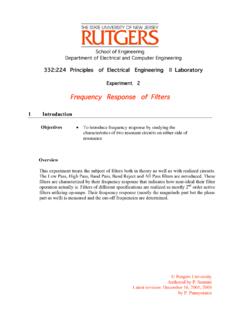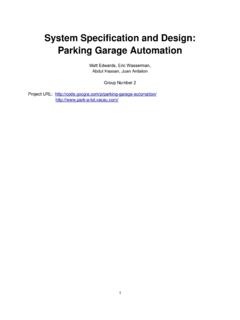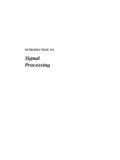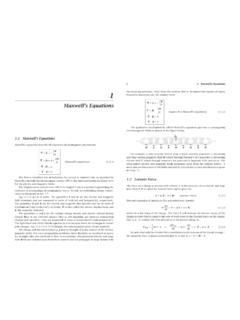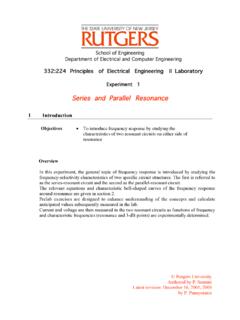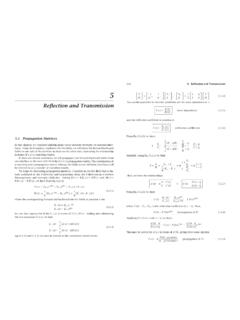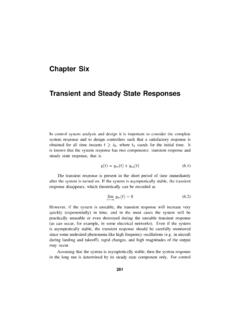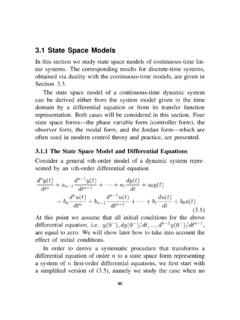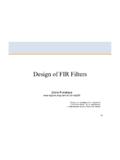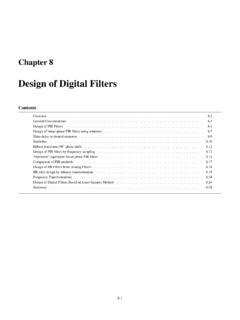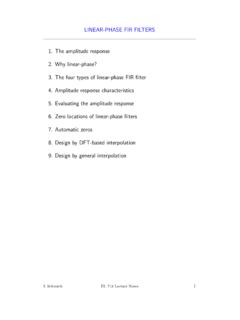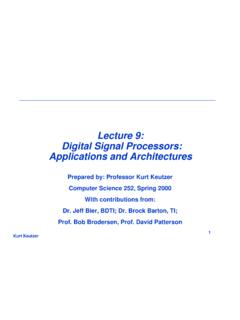Transcription of Signal Processing - Rutgers ECE
1 INTRODUCTION TOSignalProcessingINTRODUCTION TOSignalProcessingSophocles J. OrfanidisRutgers ~orfanidi/intro2spTo my lifelong friend George LazosCopyright 2010 by Sophocles J. OrfanidisThis book was previously published by Pearson Education, 1996 2009 by Prentice Hall, Inc. Previous ISBN rights reserved. No parts of this publication may be reproduced, stored in a retrievalsystem, or transmitted in any form or by any means, electronic, mechanical, photocopy-ing, recording or otherwise, without the prior written permission of the Ris a registered trademark of The MathWorks, ~orfanidi/i2spContentsPreface xiii1 Sampling and Reconstruction , of Analog Signals, Theorem, Theorem, Prefilters, Limits, of Sinusoids, Reconstruction and Aliasing, Motion, Frequency Units, of Sampled Signals , Fourier Transform, Replication, Antialiasing Prefilters, Reconstructors , Reconstructors, Reconstructors, Postfilters, Components of DSP Systems, , 552 Quantization Process, and Noise Shaping , Converters, Converters, and Digital Dither.
2 903 Discrete-Time Systems Rules, and Time Invariance, Response, and IIR Filters, and Stability, , 1174 FIR Filtering and Convolution Processing Methods, , Form, Table, Form, Form, Form, and Steady-State Behavior, of Infinite Sequences, Considerations, Overlap-Add Block Convolution Method, Processing Methods, Delays, Filtering in Direct Form, Considerations, Realizations and Circular Buffers, , 1785 z-Transforms Properties, of Convergence, and Stability, Spectrum, , , 2106 Transfer Functions Descriptions of Digital Filters, Functions, Response, Response, Response, Designs, Filters, Resonators and Equalizers, and Comb Filters, , Inverse Filters, and Stability, , 259 CONTENTSix7 Digital filter Realizations Form, Form, Form, to Canonical, Realizations and Circular Buffers, Effects in Digital Filters, , 3068 Signal Processing Applications Waveform Generators, Generators, Waveform Generators, Generators, Audio Effects, , Echoes, and Comb Filters, , Chorusing, and Phasing, Reverberation, Delays, , Limiters, Expanders, and Gates, Reduction and Signal Enhancement, Reduction Filters, and Comb Filters, and Frame Combs for Digital TV, Averaging, Smoothing Filters , , 4539 DFT/FFT Algorithms Resolution and Windowing, Computation, at a Single Frequency, over Frequency Range, , Padding, versus Computational Resolution, Form of DFT, , DFT, of Periodic Signals and the DFT.
3 Convolution, Convolution, and Overlap-Save Methods, Problems, 523xCONTENTS10 FIR Digital filter design Window Method, Ideal Filters, Rectangular Window, Hamming Window, Kaiser Window, Kaiser Window for filter design , Kaiser Window for Spectral Analysis, Frequency Sampling Method, Other FIR design Methods, Problems, 55911 IIR Digital filter design Bilinear Transformation, First-Order Lowpass and Highpass Filters, Second-Order Peaking and Notching Filters, Parametric Equalizer Filters, Comb Filters, Higher-Order Filters, Analog Lowpass Butterworth Filters, Digital Lowpass Filters, Digital Highpass Filters, Digital Bandpass Filters, Digital Bandstop Filters, Chebyshev filter design , Problems, 62812 Interpolation, Decimation, and Oversampling Interpolation and Oversampling, Interpolation filter design , Direct Form, Polyphase Form, Frequency Domain Characteristics, Kaiser Window Designs, Multistage Designs, Linear and Hold Interpolators , design Examples , 4-fold Interpolators, Multistage 4-fold Interpolators, DAC Equalization, Postfilter design and Equalization, Multistage Equalization, Decimation and Oversampling , Sampling Rate Converters , Noise Shaping Quantizers , Problems, 705 CONTENTSxi13 Appendices 713 ARandom Signals , Functions and Power Spectra, of Random Signals, 717 BRandom Number Generators, and Gaussian Generators, Noise Generators , Generators , , 733 CComplex Arithmetic in C.
4 736 DMATLAB Functions, 739 References 758 Index 775 PrefaceThis book provides an applications-oriented introduction to digital Signal processingwritten primarily for electrical engineering undergraduates. Practicing engineers andgraduate students may also find it useful as a first text on the Signal Processing is everywhere. Today s college students hear DSP all thetime in their everyday life from their CD players, to their electronic music synthesizers,to the sound cards in their PCs. They hear all about DSP chips , oversampling digitalfilters , 1-bit A/D and D/A converters , wavetable sound synthesis , audio effectsprocessors , all-digital audio studios . By the time they reach their junior year, theyare already very eager to learn more about learning of DSP can be made into a rewarding, interesting, and fun experience forthe student by weaving into the material several applications, such as the above, thatserve as vehicles for teaching the basic DSP concepts, while generating and maintainingstudent interest.
5 This has been the guiding philosophy and objective in writing this a result, the book s emphasis is more on Signal Processing than discrete-time systemtheory, although the basic principles of the latter are adequately book teaches by example and takes a hands-on practical approach that empha-sizes thealgorithmic, computational, and programmingaspects of DSP. It contains alarge number of worked examples, computer simulations and applications, and severalC and MATLAB functions for implementing various DSP operations. The practical slantof the book makes the concepts more book may be used at thejunior or seniorlevel. It is based on a junior-level DSPcourse that I have taught at Rutgers since 1988. The assumed background is only a firstcourse on linear systems. Sections marked with an asterisk ( ) are more appropriate fora second or senior elective course on DSP.
6 The rest can be covered at the junior included computer experiments can form the basis of an accompanying DSP labcourse, as is done at solutions manual, which also contains the results of the computer experiments,is available from the publisher. The C and MATLAB functions may be obtained viaanonymous FTP from the Internet the directory/pub/sjoorxiiixivPREFACEby pointing a Web browser to the book s WWW home page at the URL: ~orfanidi/intro2spContents and HighlightsChapters 1 and 2 contain a discussion of the two key DSP concepts ofsampling andquantization. The first part of Chapter 1 covers the basic issues of sampling, aliasing,andanalog reconstructionat a level appropriate for juniors. The second part is moreadvanced and discusses the practical issues of choosing and defining specifications forantialiasing prefilters and anti-image 2 discusses thequantization processand some practical implementationsof A/D and D/A converters, such as the conversion algorithm for bipolar two s comple-ment successive approximation converters.
7 The standard model of quantization noiseis presented, as well as the techniques ofoversampling, noise shaping, and tradeoff between oversampling ratio and savings in bits is derived. This material iscontinued in Section where the implementation and operation of delta-sigma noiseshaping quantizers is 3 serves as a review of basicdiscrete-time systemsconcepts, such as linear-ity, time-invariance, impulse response, convolution, FIR and IIR filters, causality, andstability. It can be covered quickly as most of this material is assumed known from aprerequisite linear systems 4 focuses on FIR filters and its purpose is to introduce two basic signalprocessing methods:block-by-blockprocessing andsample-by-sampleprocessing. Inthe block Processing part, we discuss various approaches to convolution, transient andsteady-state behavior of filters, and real-time Processing on a block-by-block basis usingthe overlap-add method and its software implementation.
8 This is further discussed inSection using the the sample Processing part, we introduce the basic building blocks of filters:adders, multipliers, and delays. We discussblock diagramsfor FIR filters and theirtime-domain operation on a sample-by-sample basis. We put a lot of emphasis on theconcept ofsample Processing algorithm, which is the repetitive series of computationsthat must be carried out on each input discuss the concept ofcircular buffersand their use in implementing delaysand FIR filters. We present a systematic treatment of the subject and carry it on tothe remainder of the book. The use of circular delay-line buffers is old, dating back atleast 25 years with its application to computer music. However, it has not been treatedsystematically in DSP texts. It has acquired a new relevance because all modern DSPchips use it to minimize the number of hardware 5 covers the basics ofz-transforms.
9 We emphasize thez-domain view ofcausality, stability, and frequency spectrum. Much of this material may be known froman earlier linear system 6 shows the equivalence of various ways of characterizing a linear filterand illustrates their use by example. It also discusses topics such as sinusoidal andsteady-state responses, time constants of filters, simple pole/zero designs of first- andsecond-order filters as well as comb and notch filters. The issues of inverse filtering andcausality are also 7 develops the standardfilter realizationsof canonical, direct, and cascadeforms, and their implementation withlinear and circularbuffers. Quantization effectsare briefly 8 presents three DSP application areas. The first is on digitalwaveformgeneration, with particular emphasis onwavetable generators. The second is ondigitalaudio effects, such as flanging, chorusing, reverberation, multitap delays, and dynamicsprocessors, such as compressors, limiters, expanders, and gates.
10 These areas were cho-sen for their appeal to undergraduates and because they provide concrete illustrationsof the use of delays, circular buffers, and filtering concepts in the context of audio third area is onnoise reduction/ Signal enhancement, which is one of the mostimportant applications of DSP and is of interest to practicing engineers and scientistswho remove noise from data on a routine basis. Here, we develop the basic principles fordesigning noise reduction and Signal enhancement filters both in the frequency and timedomains. We discuss the design and circular buffer implementation ofnotch and combfilters for removing periodic interference, enhancing periodic signals, Signal averaging,and separating the luminance and chrominance components in digital color TV also discussSavitzky-Golayfilters for data smoothing and 9 coversDFT/FFT algorithms.
